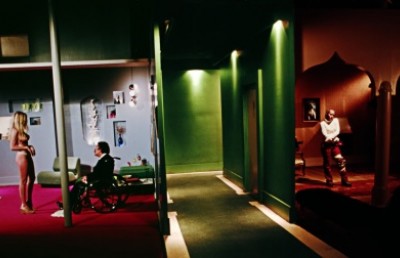Round Our House: Crispin Glover Brings His Roadshow to Montreal

Towards the beginning of Crispin Glover’s latest film, It is Fine! Everything is Fine., the filmmaker demonstrates the subtlety of his maneuvering between the ethically complicated realm of outsider art and his clear industrial savvy as professional actor with a long Hollywood CV. Linda, played by Fassbinder alum Margit Carstensen, is at a party with loud music playing. Asked to dance by a dapper looking gentleman, they strike up a conversation that remains entirely inaudible to us, viewing from a wide shot across the room. It’s as though Glover went with production sound captured from the camera’s perspective, even though the music is clearly post-synchronized. Here we find a clearly conscious move to defy the norms of speech intelligibility that govern the kind of “corporately funded media” that Glover says he is reacting against in his own work. But there’s more to it than that as we discover the narrative function of this moment that pushes much further into the politics of representation that lie at the heart of the film. Linda goes outside for some air and the music abruptly lowers on the soundtrack as the sound of crickets jump in to signal the exterior nighttime setting. There she meets Paul, the principle character played by Steven C. Stewart who also wrote the script. Paul has a serious case of cerebral palsy and has difficulty speaking, true to Stewart’s real-life condition. Yet when he strikes up a conversation with Linda, she very quickly learns to understand him and like him, agreeing to see him again soon.
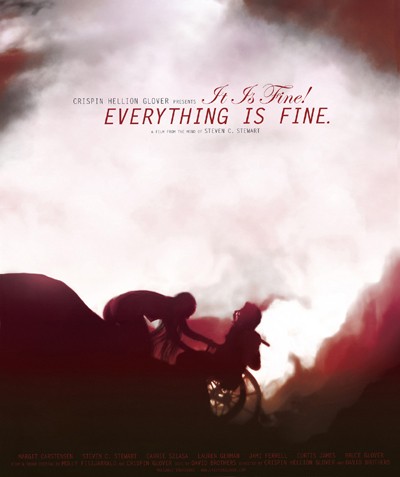
While rough around the edges, Glover’s sonic choices here are very clear in their purpose to upend our expectations around whom we should be able to hear and whom we should not, in favor of empathizing with Paul. It’s odd that this more theoretically realistic approach to the representation of sonic space is rendered so artificially. In these early minutes, the filmmaking seems almost just plain bad for the sake of bad. Glover would later comment that he takes some influence for his sound design from the Italian style that developed under Mussolini, who required post-synchronization in order to review all dialogue to make sure no dissent slipped through. Glover didn’t make the connection directly, but this is an interesting stylistic choice given how often he stressed that his films are reactions against corporate propaganda.
This sonic moment builds empathy for Paul, only then to challenge our empathy by painting him as a nasty piece of work in short order. The ease of the communication between Paul and Linda lies at the heart of Stewart’s vision for the film, in which he is free to roam the city, picking up beautiful women who never have any trouble understanding him and, after engaging with them sexually (sometimes portrayed explicitly), chokes them to death. The film frames these activities as a fantasy from inside the confines of a nursing home from which Paul is not allowed to leave, and serves to play out his psychological rage at being trapped there despite his unhindered level of intelligence. Glover explained in the Q+A afterwards that Stewart’s script, which Glover first read in the 80s, was born of the intense frustration at being derided by nursing home staff as a “mental retard” despite his lack of developmental impairment. He lived there for 10 years following the death of his mother who had acted as primary care giver. And the rage bubbled.

One of the film’s great challenges lies in the difficulty in understanding Stewart’s dialog because of the speech impediments inherent to cerebral palsy. Why no subtitles? Glover said he had to decide whether or not to fully honor the nuances of Stewart’s script and make sure that all the dialog came across unfettered. Or, be faithful to the challenge of spending time with Stewart, which entails this struggle for communication. Glover felt the latter was more true to the lived experience he wanted to imbue. Particularly important was adhering to the nature of Stewart’s fantasy, which involved the premise that any woman that he was attracted to would understand him perfectly and fall in love with him, while others would remain oblivious to the fact that Steven had fully developed mental faculties. Glover explained that this variable understanding was how it was on set at as well. Some could never learn to understand Stewart’s speech, while some had no trouble at all. And some fell in the middle, comprehending with struggle, which is where Glover positioned himself, and where I found myself as an audience member as well. And in the end, Glover suggested that “there is something almost unutterable about that which is communicated in the film,” playing off of the tension between Stewart’s clear communication with the women of his fantasy and the unspeakable nature of the acts he carries out as expression of the incomprehensible psychological turmoil that Stewart felt in that nursing home. People’s perception of severe palsy affliction is governed largely by the difficulty with which they communicate, and Stewart’s great desire was to be treated as a regular man with all the regular capabilities and desires.
Glover clearly loves to talk as well, and is very concerned with clear communication in his Q+A sessions after the films. Night two of his Montreal stand, however, featured something of a communication breakdown as one audience member kicked things off with a question about whether or not his first film, What is It?, might have crossed the line into exploitation in its use of a cast consisting almost entirely of actors with Down syndrome. She asked if he might be fetishizing the transgressive to the point where he ends up propping up the corporate media he’s so vocal about reacting against. It was a good question, but Glover immediately got hung up on her choice of words, asking for clarification about what she meant by “fetishizing” and “transgressive,” the latter of which he insists he has never claimed about his own work. She explained that it seemed like the film was foregoing narrative in favour of shock value, at which point Glover said it was a mistake to view the film as non-narrative, citing its award for Best Narrative Feature Film at the Ann Arbor Experimental Film Festival in which truly non-narrative films abound (citing Stan Brakhage’s long participation in the festival as an example). At this point there was some palpable frustration in the audience. The original questioner accused him of mansplaining cinema terminology instead of answering her question, to which he reacted with much surprise, genuinely wanting to dispel that notion and try to do justice to her question, insisting he liked these kinds of challenges and wants to make good on them. Another audience member stepped in to suggest that part of the communication problem here lies in Glover’s speaking style in which he tends to follow a line of thinking down lengthy paths before coming back around to deal with the initial spark of the question. Which certainly proved true during the previous night’s session. And then a couple of dudes jumped in to try and get things back on track by rephrasing the initial question about exploitation to get to the heart of the matter. That didn’t go over too well. But this whole exchange laid the foundation for key points about the notion of exploitation that Glover would find his way back to at several different points throughout the lengthy discussion that lasted around 90 minutes, pushing the start-time of the book signing back to midnight.

Crispin Glover as Rubin Farr in Rubin and Ed
I first saw Glover deliver a Big Slide Show in Vancouver in 1993, along with a screening of The Orkly Kid, his contribution to Trent Harris’ The Beaver Trilogy. Back then, Glover was sporting his Rubin Farr duds, a look he had been developing several years prior to Trent Harris’ Rubin and Ed, featured on the infamous Letterman appearance in 1987. He lived up to the label of “weird” that had been attached to his persona and which he cultivated for professional gain. But today’s Glover has largely eschewed this persona. Listening to him talk at length through audience questions reveals a man of composed and principled calculation about the path his career has taken, exemplified by the production history behind his latest film.
It is Fine! Everything is Fine. is the result of a long road beginning in the 80s when he had read the script, but didn’t have the means to produce the film at the time. He had soured on Hollywood after the well-known debacle on the Back to the Future sequel, for which he won a law-suit against Robert Zemeckis and the production company for unauthorized use of his image. Since then Glover has largely stuck to his guns in only accepting roles that have some psychological or moral resonance with his own ideology. But it comes at the cost of some financial instability. Years went by with this project on the back-burner, but when Stewart took ill in the late 90s it was a wake-up call that it was probably then or never. It was around this time that Glover was called for Charlie’s Angels, and he went in knowing that his take-home would go a long way towards funding his own film. It wasn’t a total compromise of his principles, however, as he managed to talk director McG into cutting the largely expositional dialogue out of his character so that Glover could play him silently, to more interesting effect and to more satisfaction for the actor. That’s how it went down, and Glover funneled all of the money into the production for It is Fine!, shot across 2000-2001.
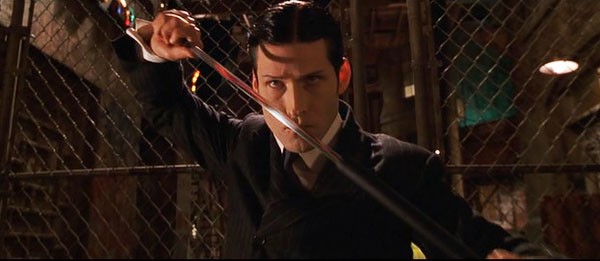
Crispin Glover as The Thin Man in Charlie’s Angels
The intensity of Glover’s ideological investment in his own projects can be seen through his insistence on the clarity of terms used to critique his work, fueled also by a history of being misrepresented in often high profile circumstances. Indeed, he has dealt with his share of criticism in the press, particularly around these two films. Some of this has been based on downright faulty information, like the time a critic who had seen the film at Sundance wrote a review that suggested the film depicted “kids” with Down syndrome having sex. All the actors in the film are adults, and there is no explicit sexuality among those with Down syndrome. After Glover’s clarification, that reviewer ended up issuing a retraction, and rightly so. As Glover put it, he isn’t breaking the law here, legality being at the forefront of his mind since the Zemeckis affair, and one of the reasons he self-distributes his own films. These things are nearly bootleg proof, and he’d like to keep it that way. Hence his insistence on absolutely no photography during his shows, for which he rewards audiences with a lengthy photo and signing session afterwards.
But once we’ve got our terms of critique sorted out, we can lay in. Let’s focus on the issue of “exploitation,” another term that Glover tried to pin down during the Q+A following What is It?. What, exactly, is being exploited in a film like this? Glover readily admits to exploiting his films for financial gain, but that’s not what most people mean when they charge him with exploitative tendencies. Some have painted What is It? as “Downsploitation,” a genre not without precedent. Glover’s response is to point out that he handles explicit sexuality differently across actors with differing developmental conditions, and in so doing he lays out his rationale pretty clearly.

In What is It?, there is a scene with two actors with Down syndrome kissing and groping through their clothes, considerably tamer than the entrance of a buck naked Steven C. Stewart in a clamshell, who then spends the bulk of the film having his penis massaged by a masked woman. As we know, Stewart has no issues with mental development and can act as a fully consensual agent. And as Glover explained, Stewart was written into the film at a relatively late stage as a way of introducing the character he would play in It is Fine!, which Glover had confirmed as the sequel while What is It? was still in production. We know that Stewart not only consented to his representation in these films; this is how he wrote himself to appear. On that level, then, we can rest assured that Stewart is not being exploited.
What about the other cast members, though? How far can those with considerable developmental issues understand Glover’s depiction of one young Down syndrome man’s subconscious at war with itself over his violent behavior towards those around him? Glover responds to this by citing an anecdote wherein a couple with DS were in attendance at one of the film’s screenings and told him afterwards how happy they were to see such a positive representation of people with this condition up on the screen. Indeed, Down syndrome has a bad history at the movies, pigeonholed to a very narrow band of representations that only fuel misunderstanding. But like most everyone else, the couple in Glover’s film hook up, and this is where so many people draw the boundary lines of their comfort zone in the sand, harkening back to the dark days when people with mental challenges were often sterilized so as not to pass their genes on down the line. For this couple in the audience, seeing two characters with DS kissing and fondling each other did them good. Which begs the question: who is the authority on labeling exploitation?
Of course there’s a lot more going on in What is It? than simply challenging Hollywood’s ableist tendencies. Did I mention the snails? Many are sliced with razors and smashed with rocks throughout the film, their screaming voiced by Fairuza Balk, part of the violence exhibited by the film’s title character, listed only as “young man” played by Michael Bleviss. PETA would not approve, and Glover acknowledged that this is perhaps the most overtly exploitative element in the film.
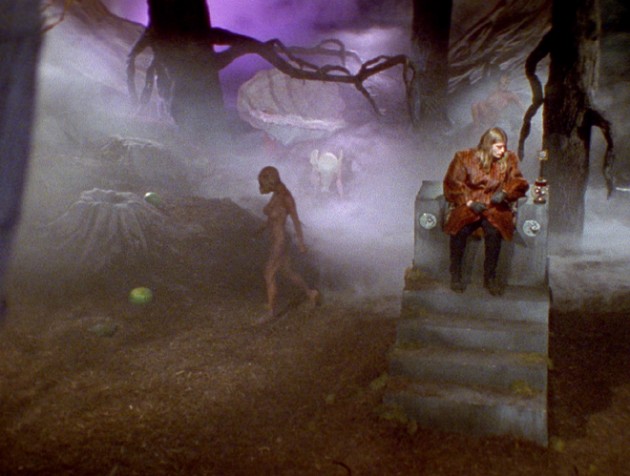
And then there’s the fascistic symbolism. The scenes set in the young man’s subconscious include swastikas, a masked black woman as the super ego’s sexual slave, and a minstrel in black face resultant from injections with snail guts. Glover himself plays the part of the young man’s id, a fur-clad dictator for whom the denizens of the subconscious perform as he sits upon his kingly throne until he is finally strangled by the super ego, the event that signals It is Fine! as the sequel/spin-off featuring Stewart’s character. On one level it’s fairly straightforward to view these evocations of fascism as metaphor for the continuing struggles between the id and the ego that the film overtly depicts, itself a metaphor for Glover’s own struggles with the domination of the corporate media industry. With this interpretation we might agree with the Q+A’s opening charge that the film sits in supportive duality of that which it takes aim at, much as the id and super ego support each other in their Freudian conflict. A piece of truly outsider art would, by definition, be devoid of engagement in this conflict altogether.
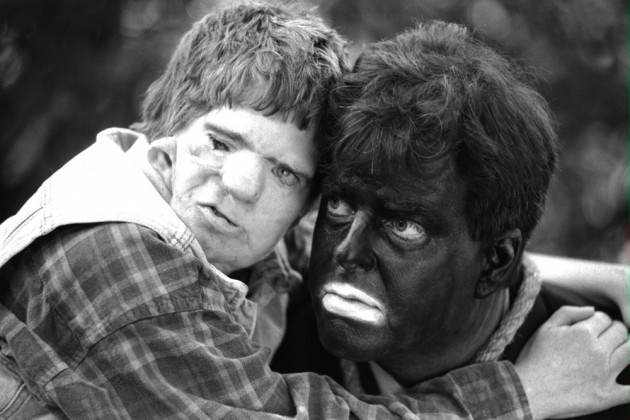
In sorting out the symbolism in these films it might serve to take a closer look at Glover’s latest book release, Round My House, one of the earliest he created but unpublished until this year. Glover read from Round My House during his Big Slide Show on both nights. Adorned with a gold foil snail set in bas-relief on its cover, the book is typical of Glover’s other publications in its collage construction and obtuse narrative.
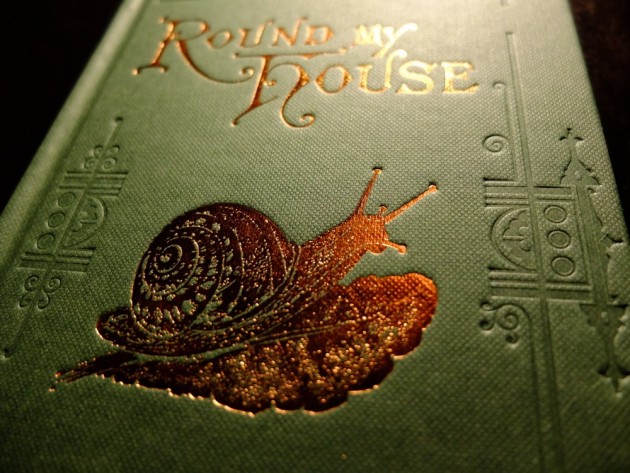
Within this style of presentation, Round My House deals rather explicitly with issues of misrepresentation. There is a thread dedicated to one Tom Wiswell, “the world’s foremost problematist,” whom the author charges with attempting to discredit him in a court of law. On an unspecified case, Wiswell submits as evidence a certain painting of the author’s back yard that the latter feels is inaccurate. As proof of the inaccuracy, the author delivers a proper rendering of the yard on the following page depicting a series of bag worms climbing a tree and jumping off its branches back down to the ground. “The realistic portrayal of my back yard only lacks information about how the bag worms walk and climb,” the author tells us. And in the live reading, Glover then gestured in front of this image projected on the screen, a series of hand movements delivering the missing information with several emphatic and strangely articulate twists of the wrist, easily the highlight of the slide show on both nights. Glover’s spirited rendition of the yard controversy left no question about the anger of the author at his friend Tom Wiswell’s unfaithfulness. One can’t help but conflate Glover’s own oft-expressed hurt and frustration over his real-life legal troubles around representation. But here it gets sticky.
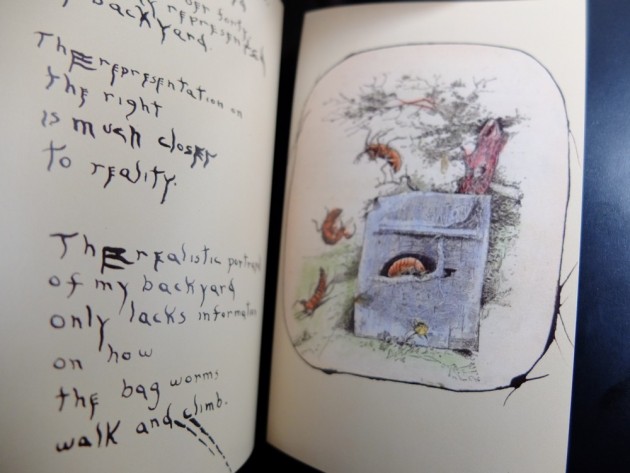
Amidst this tale of friendship betrayed appears suddenly an illustrated reference to the author’s “negroid slave” running a cold bath for his dog. Later the reference returns with mention of the slave’s son witnessing the author’s penis fall off (for reasons left unspecified), ending with a vaguely threatening statement about how such rude behavior will get that “boy” killed. What is this about, exactly? Created in 1986, just after Back to the Future, the book’s odd conflation of the era of slavery and the problems of misrepresentation might be best understood in light of a story Glover tells about one of the issues he had with Robert Zemeckis on the film. Glover was concerned about certain elements of the script, particularly how an early draft had the McFly family of the alternate present at the end of the film host black servants as part of the wealth they enjoy in the new timeline. Glover felt this was in bad taste, and would not serve the script’s intention for the family to come off as sympathetic to the audience. They ended up changing this element, which is how Biff came to be the family’s servant at the end of the film, a result that Glover feels is much more appropriate to the story arc, allowing Biff a comeuppance properly consistent with the narrative. That Zemeckis would later subject Glover himself to misrepresentation due to the unauthorized use of his image in the film’s sequel positions Round My House as strangely prescient.
But how far can we go in reading Glover into these books of his, or in attempting interpretation at all? In collecting snippets of text and images from a host of primary sources, laying in his own hand-written text to connect the assemblage, Glover confronts the limits of authorship itself. These books are the antithesis of the premise of What is It? in which almost every character is an embodiment of some aspect of one person, and It is Fine! which delivers one man’s fantasy world. In his books, Glover channels a little Walter Benjamin, compiling a materialist history of his sources through seemingly random assemblage. And he draws, too, on William S. Burroughs’ cut-up experiments, allowing bits of newspapers to fall into their own alignment when tossed randomly about. The biggest difference is that Glover inserts his own prose to draw some line between the appropriated materials, neither leaving the pieces to speak on their own nor subjecting juxtapositions to chance operations. But the materials do speak with a voice their own, which is part of how recontextualization through collage delivers its meaning. So what do Glover, and the materials themselves, speak through these references to black slaves and a household under investigation in the courts, subject to the treason of friends and neighbors? The exploitative landowner, proud of his wormy yard and clean dog, is made the subject of exploitation himself.
Glover’s films seem much more intentional or, if not, at least created with the intention that they deliver their message clearly enough to the audience. And in tackling the taboos of disability as difference they sit amidst a robust lineage of related works. His friend Werner Herzog’s Even Dwarfs Started Small comes to mind. Herzog’s oblique handling of his characters, all little people but with conditions inconclusive, is decidedly more suspect than Glover’s own. In the DVD commentary, conversing with Glover no less, Herzog attests that he wanted his film to be as nightmarish as possible, not a goal commensurate with the sensitive handling of the politics of representation. There is an anarchic drive to Herzog’s little people, enacting all manner of atrocities in revolt against an institution of unclear purpose, that stands quite apart from the deliberate structure of What is It?’s rendering of the human psyche. On the other end of the spectrum, there lies How’s Your News?, the documentary following a group of people with various disabilities from cerebral palsy to Down syndrome as they travel across the U.S. conducting street interviews on camera. As I wrote in my coverage of the film’s presentation in Montreal some years ago, the film is deliberately hilarious, forcing the audience to confront their discomfort at the idea laughing while watching disabled people, even if the laughing is genuinely with and never at. Disabled people can be funny too, just as they can be sexual, or malicious. Glover wants all of these things at the same time.
The relationship between What is It? and It is Fine! bears a striking resemblance to Rolf de Heer’s pair of films Bad Boy Bubby and Dance Me To My Song, released in the 90s as Glover was in various stages of production on both of his films. In Bad Boy Bubby, a man-child escapes decades of confinement in his mother’s dank apartment – along with her verbal and sexual abuse – and sets out to discover the world. Towards the end of the film he meets Heather, a woman with cerebral palsy who falls in love with Bubby after he demonstrates that he can understand her every word. Heather was played by Heather Rose Slattery, who went on to script Dance Me To My Song about her own experiences with palsy, starring herself and, as Rolf de Heer made clear in the credits, effectively directed by her as well. Rose Slattery’s vision for herself on screen is rather far removed from Steven C. Stewart’s. Rose Slattery’s character Judy is sexual, but this is a real-world exploration of her needs and desires, not a murderous fantasy, and is bulletproof in its resistance to charges of exploitation. But the film shares with It is Fine! the basic drive to express how important it is for their main characters to be understood, loved, and treated as fully rounded moral agents. I don’t know if Glover has discussed any influence by de Heer’s work, but I’d be hard pressed to believe otherwise.
Returning to the question of exploitation, we’re left here with one glaring problem in It is Fine! Everything is Fine.: if we are to do as Stewart wishes and treat his character as an average person with no allowances for the difference that is so often attached to disability, then what do we get? A misogynistic asshole. The cinema has a long history of such characters, and people have flocked to revel in the 42nd Street trash of men killing women as an expression of their anger over some trauma or another. What do we make of Stewart’s self-styling if this is the end game of his plea to be seen as “normal”? And what do we make of Glover’s clearly articulated desire to stand against and outside of corporate cinema’s mandate to purge any incitement towards thought and discomfort from their product, unless such incitement proves profitable? The answer, obviously, is that Glover’s film is more than simply reactionary trash. But to recognize that, there is no escaping the fact that Stewart is different from his serial killing predecessors, and so we’re back to the problem of difference in disability.
Glover emphasized how strongly he feels that It is Fine! Everything is Fine. is the best film he’ll ever have anything to do with, though he recognizes that many won’t agree with him on this. For Glover, the reasons are largely personal. Seeing this project come to fruition was to honor the wishes of his friend Stewart, to do justice to his intellect and imagination, so often overlooked in cerebral palsy patients, the hell that Stewart himself lived for a decade. Glover considers the film a documentary of Stewart enacting the fantasy that he had written for himself to enact. And in the end, it would be Stewart’s final act. Glover relayed to us the gut-wrenching story of how his friend had taken ill again after the shoot and called the director to ask if he had enough footage to finish the film. If so, Stewart told him, he would give up his fight, forgoing the recommended surgery and ask to be taken off of the machines currently keeping him alive. They did indeed have enough footage, though Glover was faced with the difficult decision about whether or not to be honest about this. In the end, Glover told his friend the truth, and Stewart died shortly thereafter without having seen the finished product. But through that finished product, Stewart lives on. The message embodied by the raging desire to be understood and loved that Stewart wrote into the script is one that truly stands apart from confrontational engagement in the ongoing wrestling-match between pop culture and counterculture that frames Glover’s first film. And for that, It is Fine! exploits only the substance of the empathetic communication Glover and Stewart enjoyed.

When I went to get my Japanese laserdisc of David Lynch’s Hotel Room signed on the second night, Glover asked me which of his two shows I had liked better. I answered that when I was watching It is Fine!, deliberately programmed out of order on the first night, I was a bit disappointed that it wasn’t in the same vein as what I had heard about What is It?, which, as confirmed when I saw it the night after, was more conventionally experimental, in line with much of the avant-garde cinema that I knew and loved. But while ruminating during the Q+A, I decided relatively quickly that It is Fine! proved to be the more poignant, interesting, and important film in the end. He was happy to hear it. And impressed with my laserdisc, which he claimed never to have seen before. Well worth the exorbitant price I paid for it on eBay after waiting nearly 25 years for Glover’s path to cross mine after our first meeting in Vancouver in 93. Hopefully it won’t be another 25 years before I can find out where the third installment in his trilogy, It is Mine, falls into the scheme of things. Wherever that may be, I’m certain it will be worth the wait. For the moment, It is Fine! Everything is Fine. will do just fine indeed.
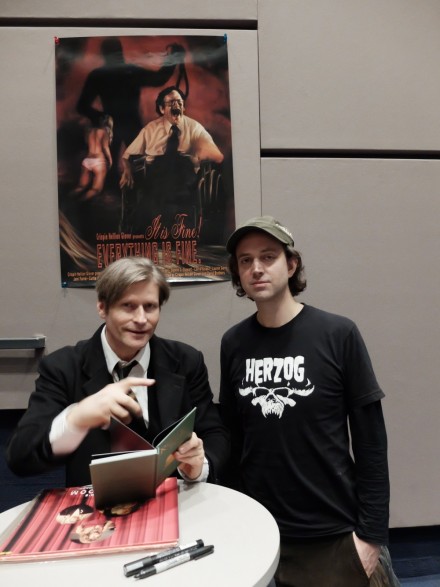



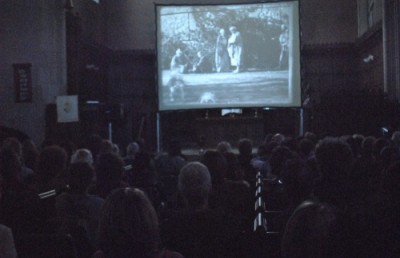
_400_258_90_s_c1.jpg)
